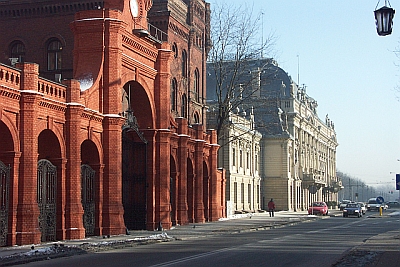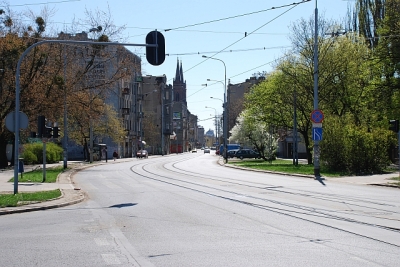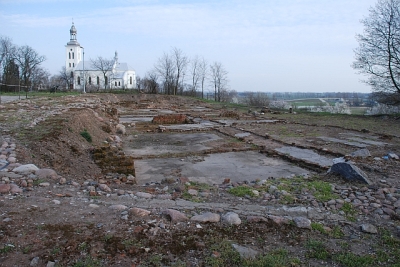 In the 19th century, Lodz was a powerful manufacturing center in the European textile industry. From the beginning, the city owed its great development to a unique multicultural mix of Poles, Germans and Jews.
Russians were also present, but they constituted only a small percent of the population. Before' the Second World War, every tenth person of the 672,000 inhabitants of Lodz claimed German roots, and more than a third of the population was Jewish. Lodz had the second largest Jewish population in Poland.
In the 19th century, Lodz was a powerful manufacturing center in the European textile industry. From the beginning, the city owed its great development to a unique multicultural mix of Poles, Germans and Jews.
Russians were also present, but they constituted only a small percent of the population. Before' the Second World War, every tenth person of the 672,000 inhabitants of Lodz claimed German roots, and more than a third of the population was Jewish. Lodz had the second largest Jewish population in Poland.
The Jews had built many factories, hospitals and tenement houses here.
Later, they also opened up theaters, cinemas and schools. The cultural life flourished as the Jewish population grew. Yiddish newspapers and books were published; theater performances were staged Yiddish. There were private schools and libraries; numerous political parties and social organizations were set up. Obviously, synagogues and prayer houses also colored the picture, since religion was an essential element of that community's tradition. In 1939, the Jewish inhabitants in Lodz exceeded 231,000.
*
Soon after the Second World War broke out, several thousand of the city's Jewish residents escaped to the east. Later, many of them found themselves in the Soviet Union. Only a few managed to escape to Western Europe and, subsequently, overseas. Those who stayed in Lodz were exposed to humiliation and pain from the very beginning of the Nazi occupation.
Repression toward the inhabitants of Lodz started immediately after the German forces occupied the city. Announcements of bans and injunctions issued by the occupiers appeared on one wall after another. The Nazis arrested representatives of the Polish intelligentsia and clergy, and closed down Catholic churches and schools. In November 1939, they destroyed the monument dedicated to Tadeusz Kosciuszko, the legendary Polish general and symbol of Polish patriotism. The greatest repression, however, was directed towards the Jewish community.
The German occupiers were planning to incorporate Lodz into the Third Reich and wanted to create a "racially clean" city. As the Nazi policies saw it, there was no place for the Poles, and most especially not for the Jews.
Their situation worsened week by week.
Every day hundreds of Jews were forced by the Nazis to do hard labor at no pay. They were beaten and humiliated. Restrictions towards them were tighter and tighter, thus it became increasingly difficult for the community to function. There was a ban on trade, an order to mark all shops and factories with symbols indicating their owners' nationality, a ban on walking along Piotrkowska Street and in municipal parks, a requirement to step off the pavement for Germans, a ban on using public transportation, an order to wear armbands, and later Stars of David . . .
The Lodz synagogues were set on fire.
The necessity to create a separate district for the Jews was mentioned by the occupation authorities as early as December 1939, but the decision was made in February 1940. All Jews from throughout the city had to move to the ghetto. Poles and Germans who lived in that part of the city destined for the special Jewish district were pushed out. Initially, the Jews felt relieved. They hoped that the confined district would protect them from antisemitic attacks and robberies. No sane person could imagine the horrors that loomed ahead.
 The ghetto was finally sealed off and isolated from the rest of the city on April 30, 1940. Lodz was now officially deemed Litzmannstadt, named after General Karl von Litzmann, a follower of Hitler and commander of the German army during the so-called Battle of Lodz in 1914.
The ghetto was finally sealed off and isolated from the rest of the city on April 30, 1940. Lodz was now officially deemed Litzmannstadt, named after General Karl von Litzmann, a follower of Hitler and commander of the German army during the so-called Battle of Lodz in 1914.
The Litzmannstadt ghetto was established in Baluty and the Old Town area. It was the most impoverished part of the city. Over 180,000 people were crowded into' an area of 4.13 square kilometers.
Pretty well from the very start, this Jewish district was a huge labor camp.
It furnished the Reich with garments, shoes and other necessary goods, particularly for the military. Orders placed by private individuals were also filled. The German occupiers needed the ghetto and that is why it continued to exist. But the work conditions were excruciatingly cruel for the Jews.
By the end of 1941, about 20,000 Jews from Austria, Czechoslovakia, Luxemburg and Germany were brought to Lodz, along with more than 5,000 Gypsies from the Burgenland (Austro-Hungarian border). Jewish inhabitants from the neighboring towns and villages of Lodz were also shipped to the ghetto. In total, more than 200,000 people would pass through the Lodz ghetto.
 Approximately 45,000 people died of starvation, cold and emaciation.
They were buried in the Jewish Cemetery, mainly in the so-called Ghetto Field. In 1942, after the "final solution of the Jewish question" was made, the Jews of Litzmannstadt were deported to the death camp at Chelmno-nad-Nerem (Kulmhof, in German). However, enough Jews were left in the ghetto to continue to do slave labor for the Reich. Even young children worked.
Approximately 45,000 people died of starvation, cold and emaciation.
They were buried in the Jewish Cemetery, mainly in the so-called Ghetto Field. In 1942, after the "final solution of the Jewish question" was made, the Jews of Litzmannstadt were deported to the death camp at Chelmno-nad-Nerem (Kulmhof, in German). However, enough Jews were left in the ghetto to continue to do slave labor for the Reich. Even young children worked.
The Lodz ghetto functioned until the summer of 1944. It lasted longer than any other ghetto. All other ghettoes were destroyed in 1942 and 1943.
The liquidation of the Lodz ghetto began on June 23, 1944. By July 14, the Nazis deported more than 7,000 people to Chelmno-nad-Nerem. From August 9 to 29, about 70,000 Jews were sent off to Auschwitz-Birkenau.
Records suggest that approximately 145,000 people from the Lodz ghetto were murdered in the death camps. An estimated 5,000 to 12,000 people survived the war, but exact figures are unknown. Most of the survivors eventually left and started new lives abroad.
For decades, not much attention was paid to the memory of the Lodz ghetto. In 1956, a small monument was erected at the Jewish Cemetery to commemorate the victims of the ghetto and the death camps. In 1984, a plaque on a building at 1 Limanowskiego St. was unveiled. Ten years later, there was a symposium and an exhibition on the history of the ghetto.
But it wasn't until nearly 60 years after the war that Lodz commemorated the annihilation of its Jewish community with the dignity and respect it warranted. Recently, there have been numerous exhibitions, concerts and publications. The horrific events of the past have only started to receive attention in schools and universities. Commemorative plaques began to appear on buildings where important ghetto institutions, offices and departments were located.
*
Although many key ghetto sites can still be found in Baluty, this chapter of the city's history is relatively unknown for a good number of its residents and the visitors that come here. Many people in Lodz still do not really know what happened in this confined district during those dark years. This book will help tell the story about that time and place. It is hoped this will be a kind of guidebook for all those who want to learn about the Lodz ghetto and of the people who were imprisoned there between 1940 and 1944.

 Home
Home
